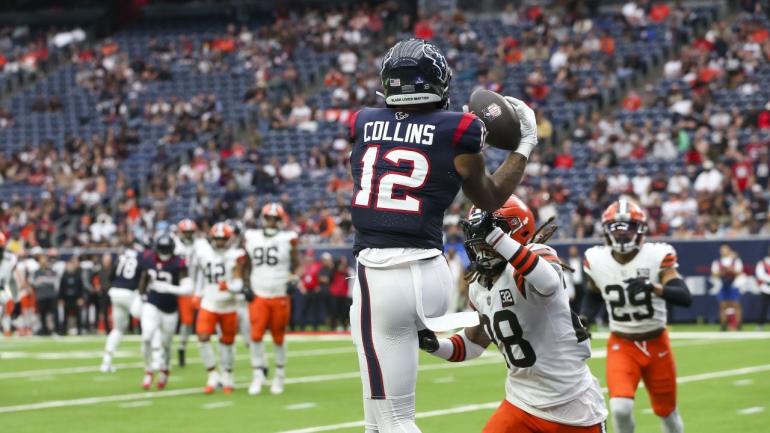
If you Google the phrase "yards per route run," the results pervasively portray a level of confusion regarding the metric and its relevance. Maybe you've heard the phrase before and wondered why Fantasy football analysts obsess over it, placing so much emphasis on a player's yard per route run rate.
Fantasy football is a hobby that allows NFL fans to deepen their connection to and love for the game of football. But really, Fantasy football exists as its own unique and sovereign space. It is rarely a reflection of real-life football. Fantasy football results reflect a player's ability to compile whichever arbitrary stats that we as a group decide are worth points. A running back can catch a pass behind the line of scrimmage, trip over his feet, lose yardage, and still accrue Fantasy points.
Your Fantasy football league – whether it rewards one, half, or no points per reception, whether it allows you to guess which kicker might send that beautiful oblong ball through the uprights on any given week, whether you're playing to win big money or bragging right over your buddies – whatever your Fantasy football experience may be, it exists separate from the game that we watch on Sundays. Real-life football is described by statistics. Fantasy football is produced solely from statistics. By nature, the Fantasy football community tends to be a bit obsessive about analytics.
Over time, a collective attempt to perfect the process of predicting player statistical outcomes has led to a number of "made up" analytics that illuminates potential future Fantasy value. Some prove to carry a strong correlation to Fantasy production, while others settle in as cool descriptors of what we're seeing on the field.
A select few of these "made up" stats actually prove to be more predictive of future Fantasy points than a player's past Fantasy point totals! You guessed it, yards per route run is one of those stats. It's time to get on board with the glorious yard per route run movement and win some Fantasy football championships.
I invite you to consider approaching Fantasy football through a per-route lens. It's not just yards per route run, there's more! We have access to all sorts of awesome per-route data – targets per route run, yards per route run, and even first downs per route run – and I believe that this information is the next wave of improving Fantasy football analysis. It would be my honor and joy to help you learn more about how to apply it and accomplish all of your wildest Fantasy football dreams.
Seven YPRR gems to target in your drafts
For the purpose of today's discussion, we're going to focus more on per-route results than any process or theory behind them. Using per-route data, I have highlighted seven players who I am excitedly targeting in Fantasy football drafts. I'm happy to share these results with you, and if you want to know more about players who weren't mentioned in this space, I will again invite you to follow that curiosity to the FFT newsletter.
Brandon Aiyuk and Nico Collins joined Tyreek Hill as the only three players to record a yard per route run rate above 3.00 while running 300 or more routes in 2023. Over the past 10 years, Julio Jones (three times), Cooper Kupp (in 2021) and Hill (2022) are the only other such instances, for reference.
As alluded to already, Kyle Shanahan's schematic design and frequent use of two-receiver sets boosts per-route stats. Texans offensive coordinator Bobby Slowik hails from the Shanahan coaching tree, but Houston actually used three-receiver sets 61% of the time – right in line with the NFL average. The Niners used three-receiver sets only 47% of the time. I filtered out any plays involving two or fewer receivers to see just how much these players benefited from their respective offensive schemes, and what I found was super interesting.
Aiyuk's yard per route run rate plummeted from 4.11 with two or fewer receivers on the field to 2.00 on plays with three or more receivers. That 2.00 rate is still strong, ranking 16th among 105 qualified (minimum 200 routes) receivers. Still, the "Shanahan effect" was real. Without filtering out plays with two or fewer receivers on the field, Aiyuk's per-route data looks historically elite. With it, he looked more like Mike Evans or Amari Cooper.
Filtering out plays with two or fewer receivers barely impacted the per-route data for Collins. That's an extremely encouraging signal regarding his future outlook.
Best single-season yard per route run rates on plays with three or more receivers on the field, 2019-23 (data courtesy of TruMedia):
| Year | Player | YPRR |
| 2023 | Tyreek Hill | 3.83 |
| 2021 | Cooper Kupp | 3.20 |
| 2020 | Davante Adams | 3.00 |
| 2022 | Tyreek Hill | 2.90 |
| 2023 | Nico Collins | 2.87 |
| 2019 | Michael Thomas | 2.85 |
| 2021 | Davante Adams | 2.79 |
| 2021 | Ja'Marr Chase | 2.74 |
| 2022 | Justin Jefferson | 2.72 |
| 2022 | A.J. Brown | 2.68 |
| 2021 | Justin Jefferson | 2.65 |
| 2020 | A.J. Brown | 2.62 |
| 2023 | A.J. Brown | 2.60 |
| 2023 | Puka Nacua | 2.60 |
Throw out any preconceived notions you may have had about Nico Collins. The only players on that list who did not go on to post multiple top-10 Fantasy WR point per game seasons were Cooper Kupp and Michael Thomas, each being prevented from doing so by health. Every other receiver on that list went on to achieve continued Fantasy superstardom. Draft Nico Collins. Draft Puka Nacua.
You can find the other five must-target wide receivers based on YPRR data and more analysis in the full piece over at Sportsline.
















